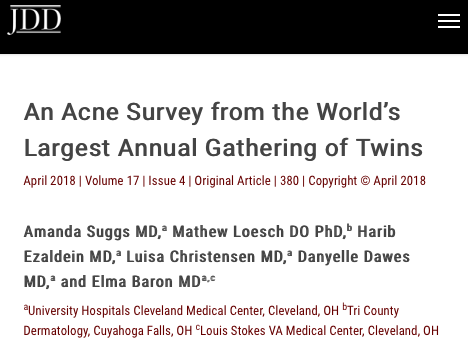Study also reveals social and environmental factors that influence acne severity
NEW YORK, April 27, 2018 /PRNewswire/ — A survey of identical and fraternal twin pairs at the Twins Days Festival in Twinsburg, Ohio, and published in the April issue of the Journal of Drugs in Dermatology, shows the skin condition may be primarily caused by genetics. Study findings show the proportion of pairs where twins have acne was significantly higher in identical (64 percent) versus fraternal (49 percent) twins.
“Since identical twins have the same genetic makeup, they make the perfect study group to see if acne is caused more by genetics or environmental factors,” said dermatologist Elma Baron, MD, professor of dermatology at Case Western Reserve University, Cleveland, and chief of dermatology at Louis Stokes Cleveland VA Medical Center.
Participating in the survey were 202 (101 pairs) identical and 53 (26 sets) fraternal twins, including one set of fraternal triplets. Both groups were young, predominantly female and the majority of the participants were Fitzpatrick Skin Types II or III. The survey was conducted at the 2016 festival.
Researchers also attempted to determine social and environmental factors that influence acne severity. A twin-to-twin analysis of 56 identical twin pairs who had acne yet differed in self-reported severity revealed differences that may serve as triggers, including a high-glycemic diet, higher BMI, and lower frequency of exercise compared to twins without acne.
“There is some suggestion that factors other than genetics may contribute to acne severity,” said Dr. Baron. “As was demonstrated in our study and others, people genetically predisposed to acne can reduce the intake of sugar and refined carbohydrates to help keep acne on the mild side. Using cosmetics that are non-comodegenic can also help reduce acne severity.”
Survey participants were also asked additional health questions to discover possible associations with other health conditions. Identical twins with acne were found to have a higher incidence of polycystic ovarian syndrome (PCOS), anxiety and asthma.
“Other studies have linked acne with PCOS and anxiety, but further research is needed to determine if there is a true association between acne and asthma,” said Dr. Baron.
The study may be accessed at: http://jddonline.com/articles/dermatology/S1545961618P0380X/1.
The Journal of Drugs in Dermatology (JDD), a full-color, peer-reviewed publication indexed with MEDLINE®/PubMed®, was founded by dermatologist Perry Robins, MD. Now in its 17th year, it offers one of the fastest routes to disseminate dermatologic information, and is considered the fastest growing publication in dermatology, presenting original articles, award-winning case reports, and timely features pertaining to new methods, techniques, and drug therapy in dermatology, which provides readers with peer-reviewed content of the utmost quality. The JDD is overseen by an International Editorial Board of more than 150 renowned experts and reaches more than 30,000 dermatology healthcare practitioners worldwide. The JDD is a product of SanovaWorks.
Media Contact:
Allison Sit
[email protected]
SOURCE SanovaWorks

